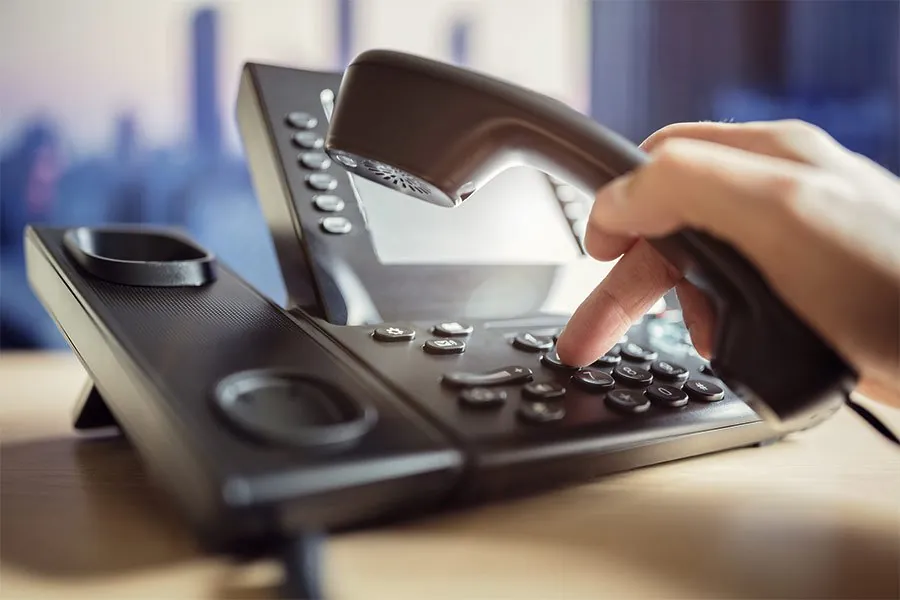How to Leave Better Voicemails as a Salesperson

One of the things that every sales person learns early on in their career is the importance of an effective voicemail after leaving countless messages that didn’t receive a callback. Believe it or not, voicemail is your opportunity to touch base on a more personal level with a client. While the quantity of replies might be lower, the quality of responses will be higher., But when it comes to leaving a voicemail, what are the best practices that get you the best rates of return?
1. Think About Who You are Calling Before You Make the Call
All leads are not the same. Rather than some generic individual at a desk, imagine a living, breathing person on the other end of the line, going through their missed calls. Think about your approach. Where did this particular lead come from? Maybe you heard about them from an existing client. Perhaps they commented on your company’s blog or they followed you on LinkedIn. Jot down a few specific points about their company or them individually Use their name. State your name and repeat it before you hang up. As much as possible, try to make each call sound like you are calling them directly about a specific opportunity for them and not just calling down a list of possible leads.
2. Choose a Time of Day that Gets You The Best Return
To get the best possible return on your voicemails, the time of day you leave them is crucial. Monday mornings and Friday afternoons are out: most people have way too much going on before or after a weekend to give their full attention to unsolicited calls, and you’ll be lucky if they get as far as your name and company before they press the delete button.
3. Speak Clearly and Be Concise
Remember, on a voicemail, the clock is ticking from the moment you hear the beep. You must be ready to go with your cheerful, upbeat, warm and positive voice. There’s no time for stammering through your intro as you finish chewing your last bite of a donut. Clear your throat before you call. Swallow. Excess saliva in your mouth can distort your voice, and the last thing you want is to disgust them with the sounds of your personal habits. You don’t get a do-over, so resist the tendency to rush. Yes, you must be quick, but the goal is to convey information, not beat the clock.
Use a normal, calm tone of voice.
While sales reps are often advised to be enthusiastic and generate excitement, that doesn’t work very well in a voicemail. It comes off as forced, artificial, and as an obvious selling ploy. Furthermore, the higher pitch is sometimes grating to a recipient’s ears. The other problem is that it results in a faster rate of speech — which, if you’re relaying important information (such as how to contact you), means the customer might have to play your message more than once to grasp everything. The odds of that happening aren’t likely. In most cases, you get one shot and one listen. Instead, use your normal conversational voice. This will naturally slow down your rate of speech and make you more easily understood. One caveat to the enthusiasm ban: If your usual speaking voice makes you sound as gloomy as Eeyore, try smiling as you leave the voicemail. It’ll lift the brightness of your tone without going overboard.
4. Get to the Hook Quickly
Factoring in the time it takes to say your name and where you’re calling from, you have mere seconds to get to the point. This is your hook. What can you do for them? What is in it for them and of value for them to call you back? A famous ad for an insurance company (you know who they are) states, “Give us 15 minutes, and we’ll save you 15% or more.” That’s what you’re going for. Eliminate all excess introductory words, and repeat after me: “Good morning, Jennifer. My name is Nick from the XYZ Company, and I recently saw you’re expanding into some new markets. We have some exciting new products that can boost your sales by 15%, and I’d love five minutes of your time to learn more about your objectives and how we may be able to help. Please give me a call back at 123-456-7890. Again, this is Nick from XYZ.” Boom.
Make your opening an unexpected one.
On the face of it, this might seem counterintuitive. Isn’t it natural to state your name and company as the opener? No. It’s commonplace. So expected, in fact, that it will get your voicemail binned without listening. The reason why is because when customers hear someone say their name and employer, they automatically know this is going to be a sales rep and thus, probably not worth their time. Instead, open with a pertinent reason for calling. For example, let’s say you’re a sales rep for Fantasia Fabrics, a linen manufacturer, and are contacting Joe Schmoe, a purchasing agent for Larry’s Linens, a retailer in household goods. Your voicemail could start like this: “Hi, Joe. I read the other day that Larry’s Linens’ revenues dropped in the 4th quarter. I’d like to talk to you about how I can help you reduce inventory costs.” Notice how the opening references your research on the company and points to a specific pain point of the customer. The second sentence provides value – reducing inventory costs, which is always of interest to a member of the procurement team (such as a purchasing agent) – particularly in tight financial times, such as a drop in revenue. Joe is much more likely to listen to the rest of your voicemail now.
30 seconds or less. 20 seconds or less is perfect.
Ever get those voicemails that ramble on for a minute or two? They seem to take an eternity to listen to, and on phones that transcribe voicemails, the transcription presents a giant wall of text. It’s another fast track to Deletion Road. The maximum message length is 30 seconds. If you can pare it down to 20 seconds or less, that’s even better. You’ll have to be succinct to get in the required information while still maintaining a slower, easier to understand voice with that time limit, but such is the path to effective voicemails.
Don’t close with a sales or begging call for action.
In this milieu are closes like “Please contact me at your earliest opportunity” and “I’ll check back in a week.” This reeks of desperation and can annoy your customer, who prefers to respond to you on their own terms. Instead, this is where you introduce your name, company, and phone number – with a repetition. To go back to our original example:
“Hi, Joe. I read the other day that Larry’s Linens’ revenues dropped in the 4th quarter. I’d like to talk to you about how I can help you reduce inventory costs. I’ll follow up via email with a couple days and times. My name is FirstName LastName with Fantasia Fabrics, and my phone number is (123) 555-5555. Again, my name is FirstName and my phone number is (123) 555-5555.”Relevant research + interest hook + email follow-up + contact info repeat close = winning voicemail message.
Considering most business calls these days go to voicemail, it’s important to not only leave messages, but communication that furthers the sales process. Used appropriately, rather than be missed contacts, voicemails can serve as an additional sales tool in the selling arsenal.
5. Don’t Forget to Follow-Up
After a little time, you should send them an email. State that you recently called, and you wanted to follow up. Here, you can get a little more specific about the products you offer and reiterate how you can help them, but again, you want to be brief and focus on them. No matter how much you can help them, nobody wants to be bombarded with offers and opportunities. You don’t get extra points for persistence, and you can waste a lead by being too pushy.
Consider also following up with a short, action-oriented email.
A good strategy to use as a two-pronged approach is to also follow up with an email that offers two days and times for a future conversation. That not only provides two contacts, the message and reasoning is different for the voicemail and the email. Too often, we see sales reps give the same content in both voicemail and email. That’s an unnecessary duplication that runs the risk of irritating the customer. Instead, use the email as a next steps advancement from the voicemail. Using our earlier example, you’ve left a voicemail for Joe (we’ll get to a full sample message in a bit), and follow up with an email that could look something like this.
“Hi Joe,
As per my voicemail, I’m following up to schedule a time to talk about how Fabulous Fabrics can reduce inventory costs for Larry’s Linens. I have 9:30 am on Wednesday and 2:00 pm on Thursday available. Please let me know which time is best for you.
Thank you,
Your Name”
Yes, you actually have to leave a voicemail.
RingLead reports 80% of calls go to voicemail. By those numbers, if you’re relying on the 20% that connect with a person, your conversion rates are going to look ghastly, to say nothing of the shockingly low numbers of qualified leads or leads to opportunities you’re going to have. Yes, we’re repeating ourselves here. But it’s that important a point to make. So next time you find yourself needing to make a call, don’t forget the importance of leaving a voicemail!
Last Updated 12/12/2024
- 1. Think About Who You are Calling Before You Make the Call
- 2. Choose a Time of Day that Gets You The Best Return
- 3. Speak Clearly and Be Concise
- Use a normal, calm tone of voice.
- 4. Get to the Hook Quickly
- Make your opening an unexpected one.
- 30 seconds or less. 20 seconds or less is perfect.
- Don’t close with a sales or begging call for action.
- 5. Don’t Forget to Follow-Up
- Consider also following up with a short, action-oriented email.
- Yes, you actually have to leave a voicemail.

- Account Planning (11)
- Awards (51)
- Client Testimonial (37)
- Personal Branding (19)
- Podcast (11)
- Research (70)
- Sales Career Development (85)
- Sales Coaching (154)
- Sales Consulting (133)
- Sales Culture (164)
- Sales Enablement (346)
- Sales Leadership (110)
- Sales Management (243)
- Sales Negotiation (16)
- Sales Prospecting (120)
- Sales Role-Playing (18)
- Sales Training (233)
- Selling Strategies (256)
- Soft Skills (67)
- Talent Management (92)
- Trusted Advisor (27)
- Virtual Selling (42)
- Webinar (12)




























